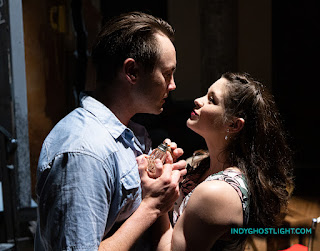Countless wrongs make a right in IRT's season-ending farce
.jpg) |
| The most upside-down scene in IRT's "The Play That Goes Wrong." |
The connective tissue of "wrongs" in "The Play That Goes Wrong" is so sturdy that Indiana Repertory Theatre's production is almost guaranteed to have any actual errors undetectable. Given the madcap helter-skelter of the farcical action, the only exception would be an actor injury, which of course nobody wants to happen. IRT's imitation of thoroughgoing chaos is orderly and mirth-provoking at every turn.
Skirting real danger, the show presents a wealth of technical and thespian ineptitude, comprising missed cues, substitute portrayals, overacting, inept blocking, and pratfalls and physical perils that bring to mind the film heyday of Harold Lloyd and Buster Keaton from about a century ago. Some of them seem to involve potential danger, or at least unplanned errors that could interfere with the errors meant to happen.
On opening night Friday, the show called up several similar memories of both deliberate and accidental mistakes from stage, screen and radio. A favorite 45-rpm disc of my youth was a few excerpts from Kermit Schafer's "Pardon My Blooper" anthology of radio mistakes (some of which caused him legal trouble because of his reliance on actors re-creating the blooper).
One of the blooper sketches echoed in "The Play That Goes Wrong' I remember like this: "Okay, you dirty rat, I'm going to kill you." (Silence.) " I have a gun and I'm really gonna kill you." (Silence). "All right, then, I have this knife, and I'll slit your throat." (Bang. Bang.)
Directed by Benjamin Hanna, the season-ender is happily positioned to lift spirits, at least facetiously, in these difficult times. To underline its success in that respect, let me just say that the word "tariff" never popped into my head over the show's two-hour length.
"The Play That Goes Wrong" originated in the United Kingdom in 2012 and has been revived often since on both sides of the pond. From it, playwrights Henry Lewis, Jonathan Sayer, and Henry Shield have generated a host of "...Goes Wrong" offspring. When you originate a franchise of high-energy spoofs, the family prospers.
The premise is that a provincial British theater company with a history of straitened circumstances and organizational lapses has mounted a two-act murder mystery titled "The Mystery of Haversham Manor." The playwrights supplied names for the cast and design team that I will mostly pass over here to use real names for IRT's people, matched to their respective character names.
While the opening-night audience settled into place, China Brickey (Annie) and Ryan Hallahan (Trevor) came out separately as crew members, anxiously checking on the readiness of the set, an upper-crust countryside home belonging to Charles Haversham (Rob Johansen). 
Under butler's anxious scrutiny, substitute fiancee tries to get her bearings.
There's some premonitory difficulty putting a mantel in place. After a welcoming speech by the uneasy, anxious-to-please Cornley director comes the triggering discovery of Haversham as murder victim. Eric Sharp plays the director, soon to turn into police inspector Carter, who will come close to being a second murder victim. There will be others similarly imperiled or at least subject to the kind of embarrassment and mental dislocation that approximates, then exceeds, the confusion faced by George Spelvin in Christopher Durang's "The Actor's Nightmare."
For facial expressiveness, it's difficult to outrecall anyone but Brett Mutter as Thomas Colleymoore, Charles' old school chum. His eye-popping portrayal quickly burrows into the spasmodic audience brain. The character sums up the earnestness of provincial acting that submits to the task of underlining each shock woven into the plot, and making sure it registers immediately, as if the whole parade were plausible.
That's nowhere near the free-form overacting that Dominique Lawson masters as Cecil, Charles' brother. He grins like the Cheshire Cat for audience approval (but never disappears), and seems to believe real acting requires gesturally mickey-mousing every line assigned to him. The Cornley actor's appetite for chewing the scenery was uproariously insatiable on opening night; the scenery was primed for destruction on its own, however, thanks to the ever-collapsing designs of IRT's Christopher and Justin Swader.
Sarah Coakley Price plays the ambivalent female love interest Florence Colleymoore, Charles' fiancee and T'homas's sister, who suffers much from the intrigue threaded throughout, and deserves most of it, even upside down. Her performance displayed an agility and gift for stereotypical hysteria, which is quickly learned by Annie when she is forced to step in for her, never "off book" except as a quick study who inevitably inspires jealousy.
Rob Johansen turns in a characterization of all-purpose physicality and delayed comic bravado as the ostensible murder victim. Clare Wilcher is Charles' loyal butler, whose professional sang-froid gets repeatedly thawed and overheated by the full range of accidents and miscues. 
Rare pause to think: Inspector Carter and Thomas
No one has to put up with more wrenching turns of events than Eric Sharp's inspector, whose struggles with a balky elevator, a suddenly slanting floor, and a passel of altercations all work to upend the methodical conventions of the police detective trade.
The actual perfection of the sets, sound, lighting, and costumes hews to IRT's predictable high standard. No technical excellence on any local stage exceeds this company's, and if there was anything that went wrong other than intended, I was unaware of it. Unsporting though it may be to recall nine years later, I do so here only to emphasize how rare it is for anything not to go right with IRT.



Comments
Post a Comment